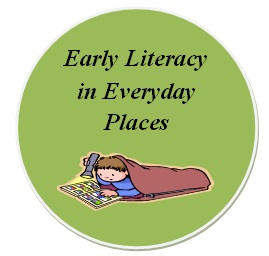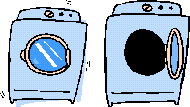 Doing the laundry is one of the best ways to incorporate early literacy activities in your daily or weekly routine. Which is why Wash Time is Talk Time has been a new initiative established by the National Coin Laundry Association, Clinton Foundation and Too Small to Fail to promote and encourage more interactions with young children.
Doing the laundry is one of the best ways to incorporate early literacy activities in your daily or weekly routine. Which is why Wash Time is Talk Time has been a new initiative established by the National Coin Laundry Association, Clinton Foundation and Too Small to Fail to promote and encourage more interactions with young children.
Although babies may be too young to help, they are still learning and listening. Narrate as you sort, wash or fold the clothes. Let them touch and smell the different fabrics in the pile after the wash. Toddlers, however, love to help and helping with the laundry is a win-win situation for early literacy and household chores. Preschoolers are adept at sorting and will proudly show off their knowledge of colors and sizes.
Sorting
Have your child sort the clothes by type (socks with socks, shirts with shirts) by color (darks, lights and whites) or by shape (dresses, pants, etc). These types of sorting activities help develop some fundamental math concepts for young children. You can introduce and expand on vocabulary by talking about the clothes and which body parts they cover. "We wear pants on our legs. Shirts cover our bellies." For the small babies, just letting them explore the texture of the different clothes is a learning resource. They can sense the difference between denim and linen, processing the touch and smell.
Counting
How many pairs of socks need to be washed? What is a pair? How many red shirts, how many multi-color shirts are there? This is a great way to introduce counting and basic arithmetic to your preschooler.
Sequencing
 Talk about the sequence of events when doing laundry. This skill is valuable for early learning. Learning about sequencing helps them become better readers because they know what to expect and can predict plotlines and outcomes in books. First we sort the clothes. Then we put them in the washer. Then the dryer, then we put them away.
Talk about the sequence of events when doing laundry. This skill is valuable for early learning. Learning about sequencing helps them become better readers because they know what to expect and can predict plotlines and outcomes in books. First we sort the clothes. Then we put them in the washer. Then the dryer, then we put them away.
More Advanced
For older toddlers and preschoolers, you can get into the specifics of how the laundry machines work and their components work. You can discuss how the soap, water and the agitator work together to scrub and clean the clothes. Depending on the type of washing machine you use, you may have a window to peak through to see it in action. Let your kids wash something by hand in sink with soap and water. This is a fun experience with bubbles that doubles as a learning tool.
You can even talk about the clothing labels and their cleaning instructions. Some instructions come with symbols. Introducing your child to the concept of symbolism with help with their reading comprehension as well as math skills as they go through school.
Make laundry time fun by playing music or singing some fun songs as you fold and put away clothes.
Suggested Reading
Mrs. McNosh Hangs Up Her Wash
Mrs. McNosh hangs up her wash with such gusto that her clothesline ends up holding the dog, a Christmas wreath, a kite, and other odd items.
A Pocket for Corduroy
A toy bear who wants a pocket for himself searches for one in a laundromat.
Knuffle Bunny
A trip to the laundromat leads to a momentous occasion when Trixie, too young to speak words, realizes that something important is missing and struggles to explain the problem to her father.
No More Blanket for Lampkin!
Ducky wants to play laundry day and wash Lambkin's blanket. But an unexpected event occurs when the blanket is washed.
Froggy Gets Dressed
Rambunctious Froggy hops out into the snow for a winter frolic but is called back by his mother to put on some necessary articles of clothing.
Naked Mole Rat Gets Dressed
Wilbur, a naked mole rat who likes to wear clothes, is forced to go before the wise community elder, who surprises the other naked mole rats with his pronouncement.


Add a comment to: Early Literacy in Everyday Places: Doing Laundry